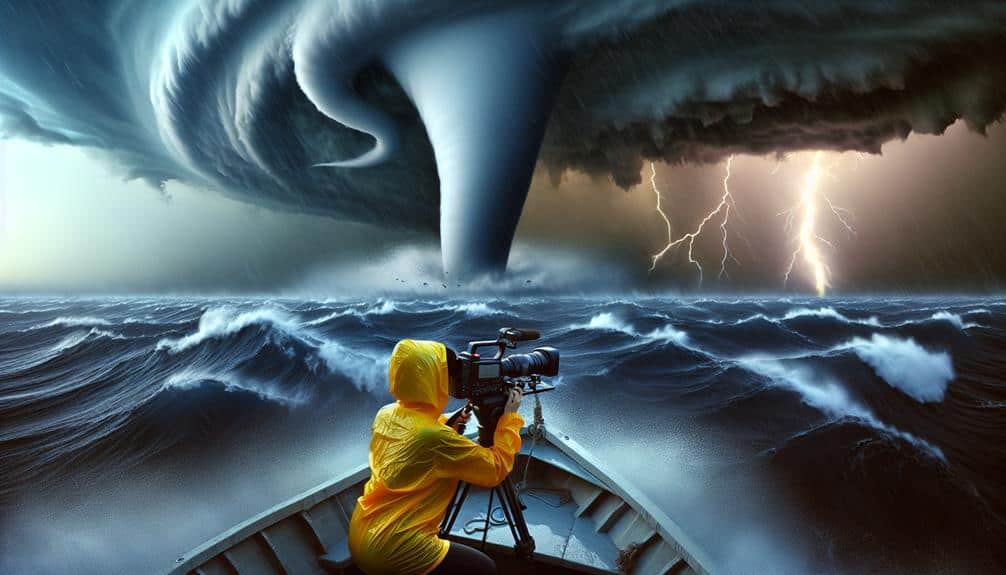When chasing waterspouts, we first analyze weather patterns using advanced forecasting techniques and high-resolution satellite imagery to predict formation. Next, we strategically choose prime locations, focusing on coastal regions and large lakes with historical waterspout activity. For example, inlets and bays with funneling effects are often hotspots. Finally, we adopt stringent safety measures, such as using two-way radios, GPS devices, and maintaining continuous weather monitoring, while adhering to maritime regulations. These strategies ensure accurate tracking and safety, essential for successful waterspout chasing. Discover more about optimizing each step for the best chasing experience.
Key Points
- Utilize high-resolution satellite imagery and Doppler radar for accurate tracking of potential waterspout formations.
- Focus on coastal regions and large lakes during late summer and early fall for prime observation opportunities.
- Monitor atmospheric conditions, including wind shear, humidity, and pressure systems, to predict waterspout likelihood.
- Equip with two-way radios, GPS devices, and traditional navigation tools for reliable communication and safety.
Analyzing Weather Patterns
To effectively chase waterspouts, we must first analyze weather patterns by examining atmospheric conditions and sea surface temperatures. By leveraging advanced forecasting techniques and thorough examination of meteorological data, we can predict when and where waterspouts are likely to occur.
Accurate storm tracking hinges on understanding the interplay between various atmospheric conditions, such as wind shear, humidity, and pressure systems.
For starters, we need reliable data sources. High-resolution satellite imagery, Doppler radar, and weather buoys provide invaluable insights. These tools help us identify regions with favorable conditions for waterspout formation. For instance, areas with warm sea surface temperatures and high humidity are prime candidates.
Next, we analyze wind patterns at different altitudes. Wind shear, or changes in wind speed and direction with height, is a critical factor. We look for areas where low-level winds converge and upper-level winds diverge. This setup often signals the potential for storm development.
Choosing Prime Locations
Having analyzed weather patterns, we now focus on identifying the best locations for observing waterspouts. To maximize our chances, we need to target specific areas where conditions are most favorable. These prime locations are often dictated by a combination of environmental factors and historical data.
- Coastal Regions: Coastal regions, especially those bordering tropical and subtropical waters, are hotspots for waterspouts. The warm water temperatures and high humidity levels create ideal conditions for their formation.
- Large Lakes: Large lakes can also be prime spots for waterspout activity, especially during late summer and early fall when the water is warmest. Look for areas with minimal wind shear.
- Inlets and Bays: Narrow inlets and bays can funnel wind and water, enhancing the likelihood of waterspout formation. Pay attention to local geographic features that can influence wind patterns.
- Historical Hotspots: Utilizing historical data, we can pinpoint locations with frequent waterspout occurrences. Areas with a history of waterspouts provide a higher probability of future events.
Safety Measures and Equipment
Securing our safety while pursuing waterspouts requires a combination of appropriate equipment and adherence to proven safety protocols. First, let's discuss emergency procedures and protective gear. We need high-quality life vests, waterproof clothing, and helmets. Each team member should be well-versed in emergency procedures, such as how to react if a waterspout changes direction suddenly.
Next, communication protocols are essential. Reliable two-way radios with a range of at least five miles ensure we stay connected, even in remote areas. We can't rely solely on mobile phones due to potential signal loss. Establishing a pre-chase briefing to outline roles, routes, and contingency plans is vital.
Navigation skills are our lifeline in the unpredictable marine environment. GPS devices with real-time updates help us track waterspout movements accurately. We should also carry traditional navigation tools like compasses and nautical charts as backups.
Lastly, continuous weather monitoring using barometers and weather apps keeps us informed. We must follow all local maritime regulations and respect nature's power, securing our chase doesn't turn into a dangerous misadventure. By combining these elements, we enhance our safety and maximize our freedom to chase waterspouts effectively.
Frequently Asked Questions
What Time of Year Is Best for Chasing Waterspouts?
We've found peak season for chasing waterspouts varies by location. In the Great Lakes, it's late summer to early fall. Essential safety tips include monitoring weather updates and using reliable equipment like radar and marine radios.
How Do Waterspouts Differ From Tornadoes?
Oh sure, let's chase whirlwinds! Waterspouts and tornadoes share similarities in their formation process. However, waterspouts form over water and are generally weaker. Despite their beauty, the dangers are real—safety precautions are essential.
What Type of Boat Is Ideal for Waterspout Chasing?
For waterspout chasing, we find sailboats advantageous due to their stability and fuel efficiency. Speedboats, though fast, have disadvantages like fuel consumption and less stability in rough waters. A sailboat offers better control and endurance for our pursuits.
Can Waterspouts Be Forecasted Accurately?
While forecasting accuracy for waterspouts has limitations, we can enhance chasing safety by taking precautions like monitoring real-time weather data and using advanced radar systems. These steps maximize our chances of safely observing these spectacular phenomena.
What Legal Considerations Should Be Kept in Mind While Chasing Waterspouts?
Chasing waterspouts is like finding your way through a maze; we must address liability concerns and safety precautions. Secure insurance coverage, acquire necessary permits, and follow regulations to protect ourselves and others, balancing freedom with responsibility.


